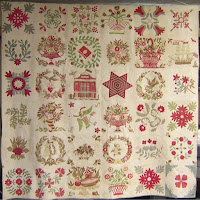Embroidery or fine ink sketches were sometimes used to add detail to the blocks. Album quilts were made and signed for a variety of occasions including weddings, presentations to a special community member and even in memory of someone who had just passed away. A commemorative quilt dedicated to a soldier who died in war might have had several blocks portraying war and patriotism while the captain of a ship may have been given a quilt with nautical motifs on it. A quilt with a block depicting deer hunting could have been presented as a coming of age quilt made for a young man. Not all album quilts were signed and some were only signed with a few names. Many had names on most or all of the blocks. Sometimes all the names, dates and verses were written by one woman who was talented at calligraphy. Most album quilts received little wear and some had thin or no batting. It is obvious they were made to be used only as decorations.
By 1840, indelible inks were also available that did not damage cloth. It was only natural that women would then take the album quilt a step further and create signature quilts. The inscriptions on the early quilts frequently included poetry and dedications.
Single pattern quilts are often referred to as "friendship quilts". Although both carried on the same tradition of signed remembrances, they were quite different. Album quilts were made up of several unique intricately pieced or appliquéd blocks. A friendship quilt was usually made of several blocks of the same pattern. These blocks could be quickly made from fabric scraps. Occasionally, one person was chosen for her beautiful handwriting to inscribe all the signatures. Some regional signature quilts were inscribed in the fraktur calligraphy used to document important events by the Pennsylvania Germans. Not all signature quilts were friendship quilts. Some were made to raise funds for various causes from missionary work to supporting troops during a war. The finished quilt may have been auctioned off or people may have paid a fee, often ten cents, to have their name placed on a block in the quilt. Sometimes a single person collected bits of fabric from others, made a block from each person's contribution then signed each block with that person's name. Some quilters sent letters and blank pieces of fabric to prominent members of a community, politicians, film stars, or other celebrities, and asked that they be signed and mailed back. The signed blocks were gathered together and incorporated into a quilt. These Celebrity quilts were used for many purposes, such as keepsakes or fund-raising.

The Memory quilt is a modern adaptation whereby a photograph is printed onto fabric. The photos may also be used in combination with signature blocks. This method also works for printing quilt labels.
Marvy Uchida Permanent Fine Point Fabric Marker $2.99
Photo Fabric Sheets $11.24
Or
Fabric Printing Pre-Soak
2 tablespoons Alum
2-1/2 teaspoons Washing Soda (not baking soda)
1/2 teaspoon Liquid Fabric Softener
1 cup Hot Water
Combine dry ingredients and fabric softener in a large bowl. Add water; it will bubble and settle.
Soak fabric for 15 minutes. Wring out fabric and dry.
Store the remaining liquid; it's reusable.
Solid light colored fabric
Freezer Paper cut to 8-1/2x11"
Iron the fabric and then iron paper to the fabric. Cut the fabric to the same size as the paper. Feed the fabric through a printer, fabric side down. Let ink dry and iron to heat set. Brush with Liquitex Varnish.
Single pattern quilts are often referred to as "friendship quilts". Although both carried on the same tradition of signed remembrances, they were quite different. Album quilts were made up of several unique intricately pieced or appliquéd blocks. A friendship quilt was usually made of several blocks of the same pattern. These blocks could be quickly made from fabric scraps. Occasionally, one person was chosen for her beautiful handwriting to inscribe all the signatures. Some regional signature quilts were inscribed in the fraktur calligraphy used to document important events by the Pennsylvania Germans. Not all signature quilts were friendship quilts. Some were made to raise funds for various causes from missionary work to supporting troops during a war. The finished quilt may have been auctioned off or people may have paid a fee, often ten cents, to have their name placed on a block in the quilt. Sometimes a single person collected bits of fabric from others, made a block from each person's contribution then signed each block with that person's name. Some quilters sent letters and blank pieces of fabric to prominent members of a community, politicians, film stars, or other celebrities, and asked that they be signed and mailed back. The signed blocks were gathered together and incorporated into a quilt. These Celebrity quilts were used for many purposes, such as keepsakes or fund-raising.
Marvy Uchida Permanent Fine Point Fabric Marker $2.99
Photo Fabric Sheets $11.24
Or
Fabric Printing Pre-Soak
2 tablespoons Alum
2-1/2 teaspoons Washing Soda (not baking soda)
1/2 teaspoon Liquid Fabric Softener
1 cup Hot Water
Combine dry ingredients and fabric softener in a large bowl. Add water; it will bubble and settle.
Soak fabric for 15 minutes. Wring out fabric and dry.
Store the remaining liquid; it's reusable.
Solid light colored fabric
Freezer Paper cut to 8-1/2x11"
Iron the fabric and then iron paper to the fabric. Cut the fabric to the same size as the paper. Feed the fabric through a printer, fabric side down. Let ink dry and iron to heat set. Brush with Liquitex Varnish.




No comments:
Post a Comment